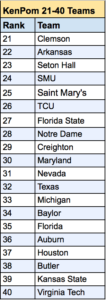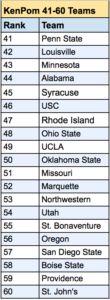Projecting the 2018 NCAA Tournament Field With 2017 Data
Posted by Will Ezekowitz on January 2nd, 2018The year 2017 is in the books and we are just beginning the conference season. With so much of a team’s “NCAA Tournament resume” still to be built, it seems like a fool’s errand to compare their relative achievements so far. All we know right now is a somewhat decent idea of which teams are actually good, but can we use resumes to date to project the future? I endeavored to figure just this out, by examining KenPom rankings at New Year’s Day with them to eventual NCAA Tournament seeding for the past five years. My conclusion indicates that, while surprises can certainly happen in the Tournament itself, teams are unlikely to significantly alter their regular season fortunes after the turn of the new year.
KenPom Rankings on New Year’s Day



For reference, here are the archived KenPom rankings as we head into 2018. They have been grouped into 20-team cohorts for convenience, and the group was limited to 60 teams because most teams ranked outsidethat range are mid-majors which will need to win their conference tournaments. The focus here will be on teams capable of building solid at-large resumes. Let’s start at the top.
Teams Ranked #1-#20 — 97% make the NCAA Tournament
This year: Villanova, Michigan State, Purdue, Duke, Virginia, Kansas, Texas Tech, Cincinnati, Gonzaga, West Virginia, Texas A&M, North Carolina, Wichita State, Arizona, Oklahoma, Xavier, Kentucky, Miami, Arizona State, Tennessee.
Top 20 teams may not have resumes to be considered Tourney locks quite yet, but their overall quality through the first seven weeks of the season suggests that they are locks anyway. The three teams that did not make it to the NCAA Tournament after strong non-conference starts in the last five years are all relatively famous: Kentucky’s underachieving 2013 squad; last year’s Indiana group that cost Tom Crean his job; and the 2015 Florida team that faded down the stretch before Billy Donovan bolted for Oklahoma City. Additionally, 36 of the 40 top-two seeds from the past five years were from this group. Bottom line is that we should expect all 20 of these teams to make the NCAA Tournament and we should feel comfortable about writing many of them into the top seed lines.
Teams Ranked #21-#40 — 75% make the NCAA Tournament
This year: Clemson, Arkansas, Seton Hall, SMU, Saint Mary’s, TCU, Florida State, Notre Dame, Creighton, Maryland, Nevada, Texas, Michigan, Baylor, Florida, Auburn, Houston, Butler, Kansas State, Virginia Tech.
Teams in the #21-#40 group have a 75 percent chance of making the NCAA Tournament. Interestingly, there is no distinction in outcome between high-major programs and mid-majors here, which have been invited in 22 of 27 instances over the past five years. Teams in this group should feel fairly comfortable about their chances of making the NCAA Tournament, but should take nothing for granted. Just ask Brad Brownell — whose Clemson team incidentally sits at #21 nationally — which fell into this group twice over the five-year window but found his team in the NIT at the end of both seasons.
Teams Ranked #41-#60 — 45% make the NCAA Tournament
This year: Penn State, Louisville, Minnesota, Alabama, Syracuse, USC, Rhode Island, Ohio State, UCLA, Oklahoma State, Missouri, Marquette, Northwestern, Utah, St. Bonaventure, Oregon, San Diego State, Boise State, Providence, St. John’s.
Now we are getting into coin-flip territory. Teams in the #41-#60 group definitely still have a reasonable chance to make the Dance, but mid-majors need to win their conferences and high-majors need to post some quality victories. And don’t expect a high seed, either; in the past three years, the only team to rise from this group or worse to a top-five seed was last year’s Minnesota, which, coincidentally, sits at 43rd.
So while we must officially wait to see how teams fill out their actual resumes over the course of the next 10 weeks, the data we have so far can give us a pretty good idea where those teams will end up on Selection Sunday. Happy 2018! Is it March yet?
NOTE: 2016’s Louisville and SMU teams which were suspended for the postseason would have made the NCAA Tournament had they been eligible, and were counted as such.









































